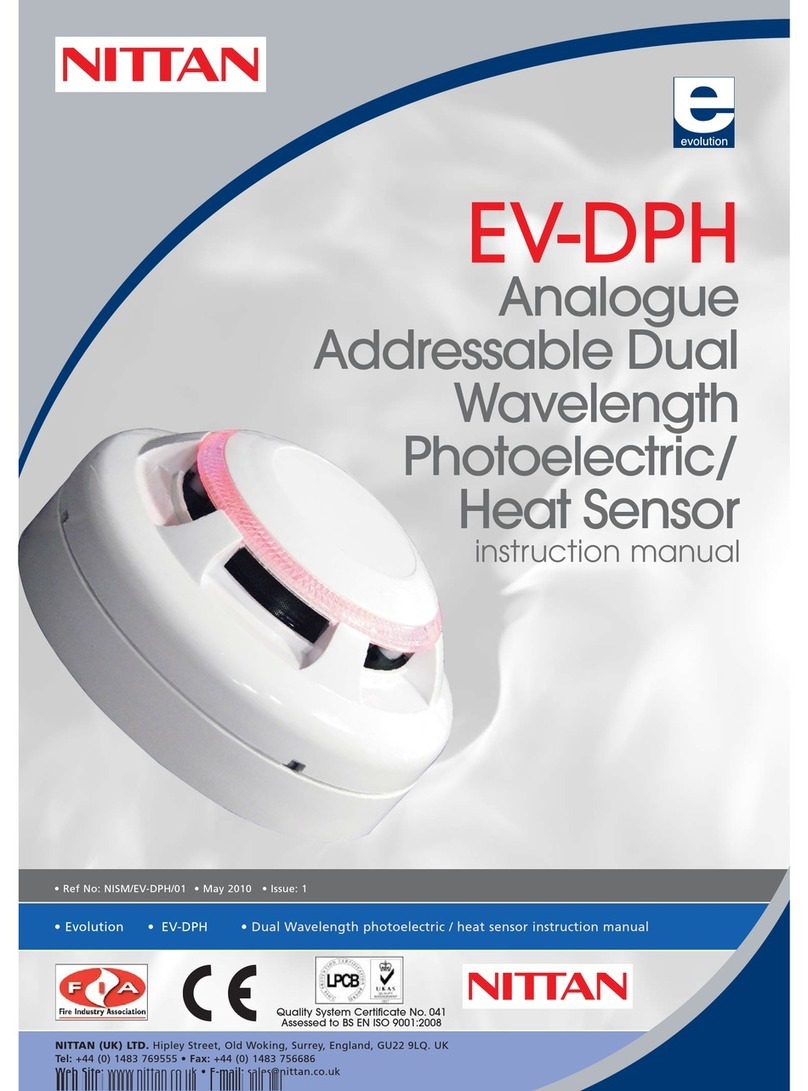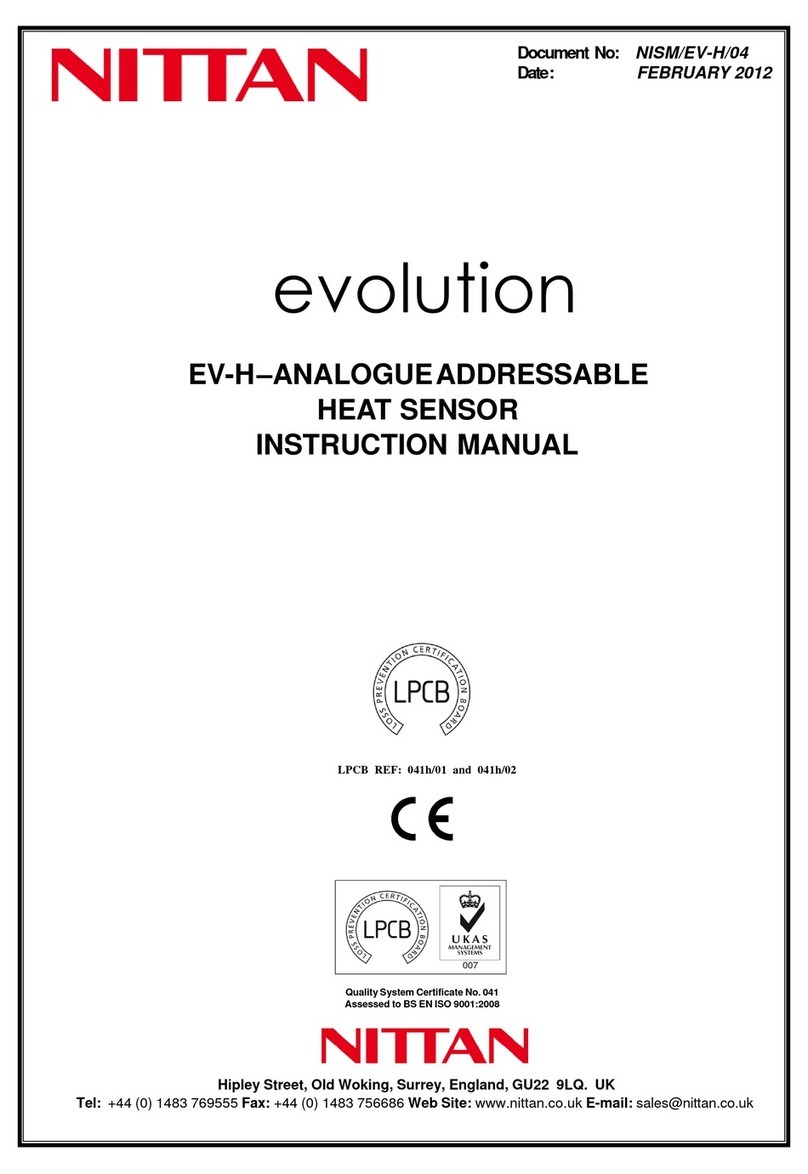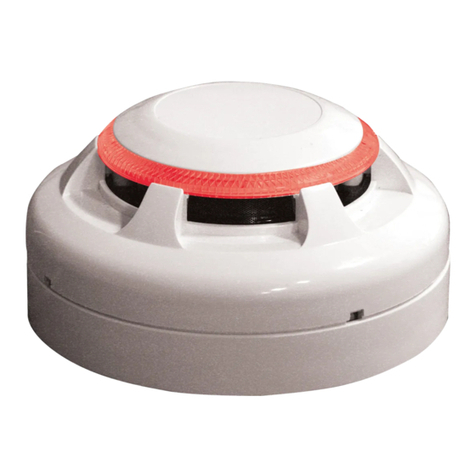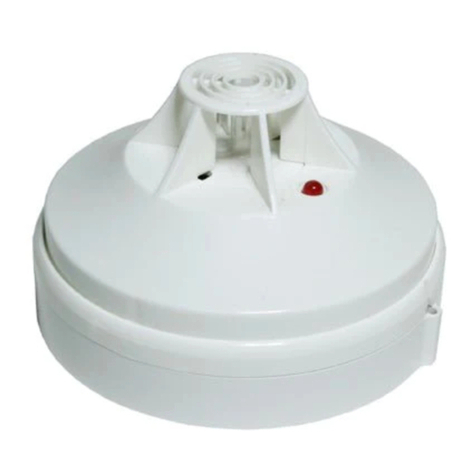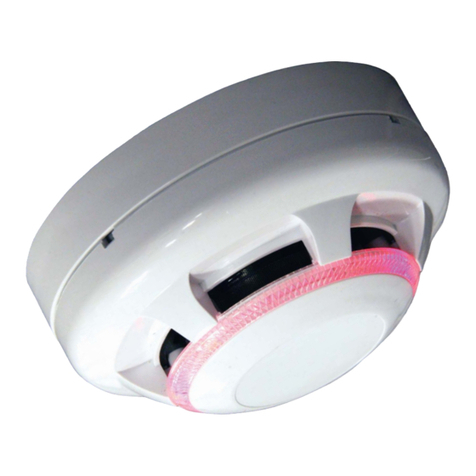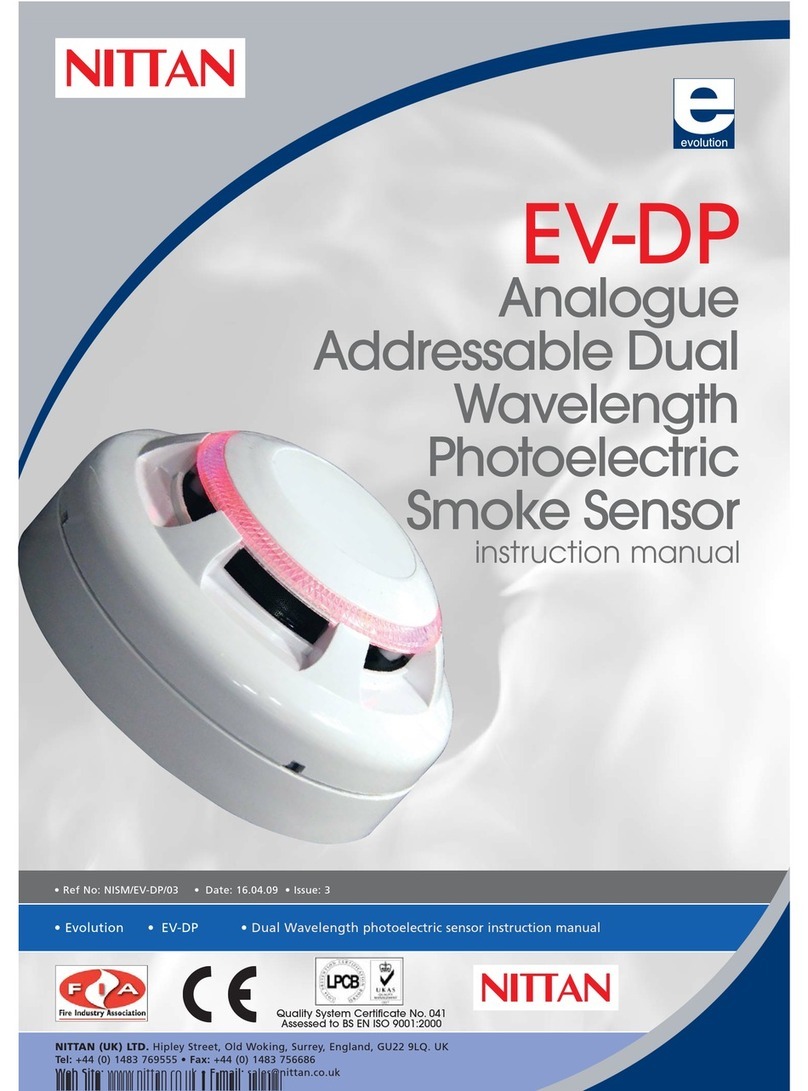Nittan EV-PYS User manual

NITTAN EUROPE LTD. Hipley Street, Old Woking, Surrey, England, GU22 9LQ. UK
Tel: +44 (0) 1483 769555 • Fax: +44 (0) 1483 756686
EVPYS
Analogue
Addressable
Photoelectric
Smoke Sensor
(With Integral Sounder)
instruction manual
Quality System Certificate No. 041
Assessed to BS EN ISO 9001
• Ref No: NISM/EV-PYS/02 • 19.02.19 • Issue: 2
• Evolution • EV-PYS • Photoelectric sensor/sounder instruction manual

Manual: EV-PYS Manual 000028 (Changes are subject to DCRN)
2
• Ref No: NISM/EV-PYS/02 • 19.02.19 • Issue: 2
• Evolution • EV-PYS • analogue addressable photoelectric sensor with integral sounder
evolution.....
The EV-PYS analogue addressable Photoelectric smoke sensor forms part
of a range of analogue addressable fire sensors from Nittan (EUROPE) Ltd
called evolution.
The EV-PYS together with the EV-PH, EV-H, EV-P are all elegantly
designed, low profile fire sensors which are aesthetically pleasing, thus
enabling them to blend unobtrusively into modern
working environments.
The evolution analogue addressable range all feature the very latest
technological advancements such as ASIC design, increasing reliability
and performance.

Manual: EV-PYS Manual 000028 (Changes are subject to DCRN)
CONTENTS:-
Section 1
Introduction Page 3
Section 2
Sensor models Page 3
Section 3
Base Models Page 3
Section 4
Installation Page 4
Section 5
Maintenance & Page 4-5-6
Cleaning
Section 6
Specifications Page 7
Section 7
Environmental
Parameters: Page 7
- Temperature Page 7
- Humidity Page 7
Section 8
EMC Page 7
Section 9
Address Settings Page 8
Section 10
Connections Page 9
Section 11
Dimensions Page 9
Section 12
Disposal Page 10
Section 13
ROHS Compliance
Statement Page 10
3
• Ref No: NISM/EV-PYS/02 • 19.02.19 • Issue: 2
• Evolution • EV-PYS • analogue addressable photoelectric sensor with integral sounder
Section 1 - INTRODUCTION
The EV-PYS is an attractively-styled, low profile photoelectric smoke sensor
for use with Nittan ‘evolution’ protocol control panels.
The EV-PYS has a chemically etched, stainless steel insect
screen therefore reducing the ingress of insects and
airborne contaminants.
EV-PYS features:
* Optical detector, detecting visible particles of combustion
* Built in sounder
* Built in Dual Line SCI (DSCI Variant)
* EEPROM addressable (hand held programmer)
* Low profile, stylish appearance
* Supplied with protective dust cover,
(remove during commissioning)
* Low monitoring current
* OMNIVIEW™ 360º LED fire alarm indicator
* Remote indicator output
* ‘EV-PYSBCN’ auxilary ouput
* Compatible with UB-6 and EV-PYSBCN bases
Section 2 - SENSOR MODELS
The EV-PYS Photoelectric smoke sensor (with Sounder) has two terminals
for connection onto the two wire loop, the DSCI variant has four (+/- in ,
+/- out). Terminal 3 provides a switched current sink function which operates
when the detector goes into Alarm (under CIE control). This is suitable for the
operation of an auxiliary function such as a remote Indicator. Terminal 3 (RIL)
is limited to 2mA. Terminal 2 provides a pulsed output to drive the dedicated
EV-PSBCN base (which is a non-addressed Beacon only base module).
The EV-PYS DSCI has a built in Short Circuit Isolator (SCI). This is offered in
a Dual Line Isolator form, where it will break BOTH the +ve and –ve lines (by
the means of 2 x Dual FET’s). The Isolator is of the ‘Semi Active’ type, where in
the event of a Short Circuit on the loop, the Isolator will automatically Isolate.
Panel intervention (either automatically or by Engineer action), is necessary
to RESET the Isolator. However, if the Short is still present, the Isolator will
re-Isolate immediately.
Section 3 - BASE MODELS
A variety of bases are available for use with the EV-PYS sensors. It is
important to use the correct base for each application. The available base
models are:
i) UB-6 base: For standard use with EV-PYS series photoelectric sensor.
ii) EV-PYSBCN base
iii) UB-6-EV: For Non-Isolated version.

Manual: EV-PYS Manual 000028 (Changes are subject to DCRN)
4
• Ref No: NISM/EV-PYS/02 • 19.02.19 • Issue: 2
• Evolution • EV-PYS • analogue addressable photoelectric sensor with integral sounder
Section 4 - INSTALLATION
In normal use, the EV-PYS sensor will be installed at ceiling level. Pass the
field wiring through the cable hole in the centre and from the rear of the
base. Offer up and affix the base to the ceiling or conduit fitting with screws
via the base mounting holes. Connect the field wiring to the base terminals,
as detailed on page 9 making sure the wiring does not obstruct fitting of the
detector head. Fit the sensor head by inserting it into the base and turning
clockwise until the notch in the detector rim aligns with base locking screw.
The OMNIVIEW™ 360º alarm indicator permits visibility from any angle.
Note: The address must be set before the sensor is fitted into place
Fit the plastic dust cover supplied over the sensor to keep out dust etc, until the
system is commissioned. If the dust cover is not fitted and the environment is
slightly dusty, such as when building work is being completed, for example,
problems of false alarms are likely to occur after commissioning unless
cleaning of the sensor is undertaken. At commissioning, the dust cover should
be removed and discarded.
NOTE: THE PLASTIC DUST COVER MUST BE REMOVED FROM THE
SENSOR IN ORDER FOR THE SENSOR TO FUNCTION CORRECTLY.
Section 5 - MAINTENANCE
AND CLEANING
Maintenance:
The EV-PYS sensor is a high quality product engineered for reliability.
If proper preventative maintenance is not carried out, there is a likelihood of
malfunction, including false alarms.
Servicing:
Servicing of the system should be carried out in accordance with
the requirements of BS 5839 Part 1, Fire Detection and Alarm
Systems for Buildings: Code of Practice for System Design,
Installation and Servicing.

Manual: EV-PYS Manual 000028 (Changes are subject to DCRN)
The maintenance procedures described below should be
conducted with the following frequency:
One month after installation: Routine Inspection and every 3
months after.
Every 6 months: Operational Test.
Every 12 months: Functional Test and Clean.
All above frequencies of maintenance are dependent on
ambient conditions.
Routine Inspection
i) Ensure the sensor head is secure and undamaged.
ii) Check the smoke entry apertures are in no way obstructed.
iii)Ensure the surface of the sensor’s outer cover is clean. If
there are deposits due to the presence of oil vapour, dust
etc, then the sensor should be cleaned in accordance with
the cleaning instructions detailed later in this manual. It
may be advisable to ensure that such cleaning is conducted
regularly in the future.
iv)Ensure no equipment which may generate combustion products has
been installed in the vicinity of the detector since the last
routine inspection. If such equipment has been installed,
then you should notify the Fire Safety Officer or other
competent authority that its presence may cause false alarms.
Operational Test
The purpose of the Operational Test is to confirm the sensor’s
correct operation in response to a smoke condition.
Note: When carrying out site testing of Analogue Addressable
Evolution detectors, the CIE shall be set to test mode prior to
beginning the tests.
i) Take any necessary precautions at the control panel to limit the
sounding of the alarm sounders/bells and any fire service
summoning device.
5
• Ref No: NISM/EV-PYS/02 • 19.02.19 • Issue: 2
• Evolution • EV-PYS • analogue addressable photoelectric sensor with integral sounder

Manual: EV-PYS Manual 000028 (Changes are subject to DCRN)
6
ii) Introduce a discrete amount of smoke into the sensor head, e.g.
using a ‘Detector Testers - Solo’ smoke test head, alternatively Detector
Testers “Testifire” smoke test equipment maybe used. Check that the
sensor gives an alarm condition within 15 seconds. Check the LED
indicator on the EV-PYS sensor illuminates and any remote indicator LED
fitted also illuminates.
iii)After the sensor has given the alarm condition, reset the sensor
from the control panel. It may be necessary to allow a short
time to elapse before resetting the sensor, to allow any residual
smoke from the test to disperse.
iv)Before proceeding to the next sensor, ensure that the sensor
previously tested does not re-operate due to the presence of
residual smoke.
Functional Tests:
The functional test checks the sensor operation. These sensors may
be returned to our factory for Functional Testing.
Cleaning:
Note: The sensor head should NOT be disassembled.
i) Carefully remove the sensor head from its base.
ii) Use a soft, lint-free cloth, moistened with alcohol for sticky
deposits, to clean the plastic casing.
iii)Using a soft bristle brush (e.g. an artist’s paint- brush) carefully
brush between the vanes in a linear motion away from the
smoke entry apertures
iv)It is permissible to blow dust from the chamber,without removing
the cover, using a clean air line.
v) If the unit needs further cleaning, or is damaged or corroded,
please return the complete sensor to Nittan (EUROPE) Ltd. for service.
• Ref No: NISM/EV-PYS/02 • 19.02.19 • Issue: 2
• Evolution • EV-PYS • analogue addressable photoelectric sensor with integral sounder

Manual: EV-PYS Manual 000028 (Changes are subject to DCRN)
7
• Ref No: NISM/EV-PYS/02 • 19.02.19 • Issue: 2
• Evolution • EV-PYS • analogue addressable photoelectric sensor with integral sounder
Section 7 - ENVIRONMENTAL
PARAMETERS
Temperature Considerations:
Over the range from -10 ºC to +55 ºC
Humidity:
Relative Humidity of up to 95%, measured at 50 ºC,
non condensing.
Section 8 - EMC
Installation
The installation shall be in accordance with the regulations either
of the approval body for an approved system, or otherwise, to the
national code of practice/ regulations for the installation of the fire
alarm system, e.g. BS 5839 part 1.
Electromagnetic Compatibility (EMC)
On a site where there is an unusually high level of potential
electrical interference, e.g. where heavy currents are being
switched or where high levels of R.F. are prevalent, care then must
be taken in the type and routing of cables. Particular care should
be given to the separation of zone wiring from the cable carrying
the interference.
Section 6 - SPECIFICATIONS
Model Reference: - EV-PYS
EV-PYS-DSCI
Computer Reference: - F20-82510
F20-82511
Sensor Type: - Photoelectric smoke sensor
Sensitivity: - Nominal 4.5%/m
Operating Current: - 200 microamps
fire alarm (LED on) 5.2mA
Sounder on 3.5 mA
RIL 2mA
Standard: - EN54 Part 7:2001 A2
EN54 Part 3:2001
EN54 Part 17:2005
Mass: - 145g (excluding base)
Charging Time: - 1 minute
Ambient Temperature
Range: - -10 ºC to +55 ºC
IP Rating: - 42C
Sounder Type - Type A Indoor
Sounder Device - Piezo
Power Consumption - 150mW Max (Sounder)
Sounder Output - 77 - 88db (A-weighted)
Directional Dependent
Sounder Tones - Standard two tone 750Hz/1000Hz
0.5/0.5sec Only
Other tone models available
on request
CPR Certificate - 0359-CPR-00640
Declaration of - 00640
Performance

Manual: EV-PYS Manual 000028 (Changes are subject to DCRN)
8
• Ref No: NISM/EV-PYS/02 • 19.02.19 • Issue: 2
• Evolution • EV-PYS • analogue addressable photoelectric sensor with integral sounder
The information displayed by the 7 segment LED cycles
every second and stops whilst displaying the [address]
at the end of the second cycle. Pressing any key at any
time during the information collection cycle, forces the
EV-AD2 to display the address, and await new
address selection.
6. +100, +10, +1 keys are used to select the
new address.
7. Press the [Set] key
a) The buzzer sounds, and all LED’s are
turned off. The EV-AD2 then starts
transmitting to the detector.
b) Do not remove the detector.
8. The 7 segment LED shows the new address and
“complete” LED lights. If an unsupported or defective
device is connected the buzzer sounds , ERROR LED is
lit and the 7 segment LED reads ERROR CODE.
9. To continue changing the address for another
detector, change the detector and then repeat
from step 3. To finish changing addresses,
turn the POWER SW off.
1 Stand by mode
EV-AD2 will switch to STAND-BY MODE to save battery
power if there is no key operation for more than one minute
after finishing changing device addresses. During the
STAND-BY MODE, 7 segment LED is blank. Power LED is
lit.
To return EV-AD2 from STAND-BY MODE press any key.
2 Instruction
1. EV-AD2 requires two 9v PP3 batteries.
a) Before inserting the batteries, confirm
the EV-AD2 is switched off and check
polarity of battery, or damage could result.
2. Turn the power switch ON.
a) For one second, all LED’s are lit and the
buzzer sounds.
3. Plug the device onto the base.
4. Press the [Search] Key
a) Buzzer sounds, then the EV-AD2 starts
transmitting to the detector.
b) Do not remove the detector when
transmitting, or damage could result.
5. The 7 segment LED reads [Customer code],
[Type of detector], [Address] in turn.
a) The buzzer sounds, ERROR LED lights and
the 7 segment LED displays an ERROR CODE
when an unsupported or defective device
is connected.
0.01 12.3 003.
Customer Code Type of detector Address
The 7 segment LED distinguishes the Customer Code,
Type and Address by the dot position in the LED.
Section 9 - ADDRESS SETTING
(EV-AD2)
(Note - Dot position)

CIE
6
5
4
3
2
1
+ve Line Out
-ve Line Out
+ve Line In
-ve Line In
RIL+ve Line Out
-ve Line Out
RIL
+ve Line In
-ve Line In
-ve Line Out
+ve Line Out
+ve Line Out
-ve Line Out
Cable shield Wire Continuity connection
esaBNCBSP-VEesaB6-BU
(Mounting Plate)
+ve Line In
-ve Line In
CIE
6
3
2
1
+ve Line Out
-ve Line Out
+ve Line In / Out
-ve Line In / Out
RIL
UB-4-EV or UB-6 Base
Non -DCSI version
RIL
+ve Line In
-ve Line In
-ve Line Out
+ve Line Out
+ve Line Out
-ve Line Out
Cable shield Wire Continuity connection
EV-PSBCN Base
(Mounting Plate)
+ve Line In
-ve Line In
DSCI Version
Non DSCI Version
Manual: EV-PYS Manual 000028 (Changes are subject to DCRN)
Section 10 - CONNECTIONS
9
• Ref No: NISM/EV-PYS/02 • 19.02.19 • Issue: 2
• Evolution • EV-PYS • analogue addressable photoelectric sensor with integral sounder
Section 11 - DIMENSIONS
CIE
6
5
4
3
2
1
+ve Line Out
-ve Line Out
+ve Line In
-ve Line In
RIL+ve Line Out
-ve Line Out
RIL
+ve Line In
-ve Line In
-ve Line Out
+ve Line Out
+ve Line Out
-ve Line Out
Cable shield Wire Continuity connection
esaBNCBSP-VEesaB6-BU
(Mounting Plate)
+ve Line In
-ve Line In
CIE
6
3
2
1
+ve Line Out
-ve Line Out
+ve Line In / Out
-ve Line In / Out
RIL
UB-4-EV or UB-6 Base
Non -DCSI version
RIL
+ve Line In
-ve Line In
-ve Line Out
+ve Line Out
+ve Line Out
-ve Line Out
Cable shield Wire Continuity connection
EV-PSBCN Base
(Mounting Plate)
+ve Line In
-ve Line In
DSCI Version
Non DSCI Version
27 mm
43 mm
20 mm
41 mm
4.5 mm
9 mm
2.8 x 6 mm
GRUB SCREW
15 mm
104.5 mm
EV-PYSBCN EV-PYS + BASE UB-6-EV or UB-6

Manual: EV-PYS Manual 000028 (Changes are subject to DCRN)
10
Section 12 - DISPOSAL
This symbol on the EV-PYS indicates that this product must not be disposed of
with household waste. Instead, it is your responsibility to dispose of your waste
equipment by handing it over to a designated collection point for the recycling
of waste electrical and electronic equipment. The separate collection and
recycling of your waste equipment at the time of disposal will help to conserve
natural resources and ensure that it is recycled in a manner that protects
human health and the environment. For more information about where you
can drop off your waste equipment for recycling, please contact your local
city office or your household waste disposal service.
Section 13 - ROHS COMPLIANCE
STATEMENT
(RoHS compliant and lead-free)
This product complies with the European Union RoHS (Restriction of
Hazardous Substances) directive 2011/65/EU which restricts the use of
the following six hazardous materials in the manufacture of electronic and
electrical equipment.
• Lead (Pb)
• Hexavalant Chromium
• Mercury (Hg)
• Cadmium (Cd)
• Polybrominated biphenyls (PBB’s)
• Polybrominated diphenyl ethers (PBDE’s)
• Ref No: NISM/EV-PYS/02 • 19.02.19 • Issue: 2
• Evolution • EV-PYS • analogue addressable photoelectric sensor with integral sounder
Table of contents
Other Nittan Accessories manuals
